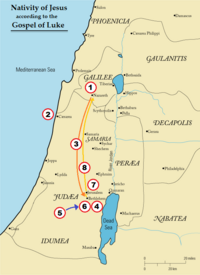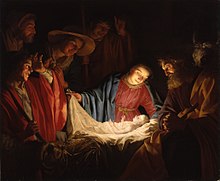| Luke 2 | |
|---|---|
 Luke 6:4-16 on Papyrus 4, written about AD 150-175. | |
| Book | Gospel of Luke |
| Category | Gospel |
| Christian Bible part | New Testament |
| Order in the Christian part | 3 |
Luke 2 is the second chapter of the Gospel of Luke in the New Testament. It contains an account of Jesus's birth and an incident from his childhood. Verses 1–19 except 2 are commonly read at Nativity plays as part of celebrating Christmas.
Text

Legend: 1. Annunciation to Mary in Nazareth. 2. Census of Quirinius (historically carried out by prefect of Judea from Caesarea) 3. Joseph and Mary travel from Nazareth to Bethlehem 4. Birth of Jesus in Bethlehem 5. Annunciation to the shepherds ('nearby' Bethlehem, Luke 2:8) 6. Adoration of the shepherds in Bethlehem 7. Presentation of Jesus at the Temple in Jerusalem 8. Joseph, Mary and Jesus return home to Nazareth
The original text is written in Koine Greek. This chapter is divided into 52 verses.
Some of the most ancient manuscripts containing this chapter are:
- Codex Vaticanus (AD 325-350)
- Codex Sinaiticus (AD 330-360)
- Codex Bezae (ca. AD 400)
- Codex Washingtonianus (ca. AD 400)
- Codex Alexandrinus (ca. AD 400-440)
- Codex Ephraemi Rescriptus (ca. AD 450)
Jesus's birth (2:1–7)

According to the Gospel of Luke, Caesar Augustus ordered a census be conducted of the ".. entire Roman World", during Quirinius's governorship of Syria and this is the reason that Joseph and Mary, who lived in Nazareth, were in Bethlehem, King David's place of birth, when Jesus was born. Many English translations suggest that the purpose of the census was for everyone to be registered, but the King James Version and others state that everyone was to be taxed.[1] The Expanded Bible explains that the register was compiled for taxation.[2]
According to the narrative in chapter 1, Mary had travelled from Nazareth to a city in the hill country of Judah to visit her cousin Elizabeth, and then returned to Nazareth,[3] then travelled again with Joseph from Nazareth to Bethlehem.
The accuracy of this date for the birth of Jesus has been disputed by many modern scholars.
The angels and shepherds (2:8–20)
Luke then tells of shepherds working nearby who are visited by an angel who tells them that in Bethlehem, the "...town of David...Christ the Lord." had been born. "A multitude of the heavenly host" appear, praising God and saying "Glory to God in the highest, and on earth peace..." There is some discussion over the later part of the sentence the most usual modern interpretations being "... and goodwill to men", "... towards men of goodwill" or ".. to those he favours." The ASV has for example "...among men in whom he is well pleased." which corresponds to the third reading. The line is the opening part of the Greater Doxology, and as such important in the main rites of the Christian church.
The angels then return to heaven and the shepherds go into Bethlehem to see for themselves and find Joseph and Mary and the infant Jesus. They then "...spread the word..." about the angels and Jesus, then return to their flocks.
Luke does not mention of the Magi, the Massacre of the Innocents, or the escape of Jesus' family to Egypt found in Matthew 2.
Circumcision and naming (2:21)
Luke 2:21 tells how Joseph and Mary have their baby circumcised on the eighth day after birth, and name him Jesus, as Gabriel had told Mary to do in Luke 1:31. Protestant theologian Jeremy Taylor argues that Jesus's circumcision proved his human nature while fulfilling the law of Moses and had Jesus been uncircumcised, it would have made Jews substantially less receptive to his Evangelism.[4]
Presentation in the Temple (2:22–38)

According to Leviticus 12, a woman was ritually unclean for forty days after giving birth to a male child. After this period, Joseph and Mary take Jesus to the Temple to complete Mary's ritual purification and to provide the sacrifice specified in the Law of Moses. Luke states that Joseph and Mary take the option provided for poor people (those who could not afford a lamb) in Leviticus 12:8, sacrificing "a pair of doves or two young pigeons."
In the Temple, they meet Simeon and Anna. Simeon had been waiting for the Christ, and believes Jesus is him. Simeon prays the Nunc Dimittis (Canticle of Simeon) and tells Mary "This child is destined to cause the falling and rising of many in Israel, and to be a sign that will be spoken against, so that the thoughts of many hearts will be revealed. And a sword will pierce your own soul too." Anna, an old widowed woman who spent all her time in the temple praying, comes and praises Jesus as well.
Return to Nazareth and early childhood (2:39–40)
In verses 39-40 the family return to Nazareth in Galilee, where Jesus grows and becomes strong and wise. He receives God's favour or grace. Unlike the apocryphal gospels, no preternatural stories of Jesus childhood are found in Luke, or indeed any of the four canonical gospels. Verse 40 is echoed in verse 52.
Boy Jesus at the Temple (2:41–50)

The Gospel then provides the only story of Jesus's childhood in the Canonical Gospels. When Jesus is twelve his family travels to Jerusalem for the Passover festival. Then they leave with a large group of their relatives and friends and after a day they realize Jesus is not with them. They go back to Jerusalem and after three days of looking find him in the temple talking with the temple teachers. His parents scold him for running off, but Jesus replies that they should have known where he was. "Didn't you know I had to be in my Father's house?". His family doesn't understand what he is talking about. They all then go to Nazareth.
Later childhood and youth (2:51–52)

Jesus continues to grow and flourish both in wisdom and stature, and in the favour of God and man. This mirrors verse 40, and completes Jesus' early years. The next we see of him is in Chapter 3, verse 21, when he is baptised by John the Baptist.
See also
- Brown, Raymond E. An Introduction to the New Testament 1997 Doubleday ISBN 0-385-24767-2
- Migdal Eder ("Tower of flock")
- Related Bible parts: Micah 4, Micah 5, Matthew 2
References
- ^ BibleGateway.com, Translations of Luke 2:1
- ^ Luke 2:1 EXB
- ^ Luke 1:39–40, 56
- ^ "But so mysterious were all the actions of Jesus, that this one [his circumcision] served many ends. For 1. It gave demonstration of the verity of human nature. 2. So he began to fulfill the law. 3. And took from himself the scandal of uncircumcision, which would eternally have prejudiced the Jews against his entertainment and communion. 4. And then he took upon him that name, which declared him to be the Savior of the world; which as it was consummate in the blood of the cross, so it was inaugurated in the blood of circumcision: for "when eight days were accomplished for circumcising of the Child, his name was called Jesus." - Taylor, Jeremy. The Whole works; with an essay biographical and critical, Volume 1 (1657). Frederick Westley and A.H. Davis, London, 1835. p. 51
| Preceded by Luke 1 |
Chapters of the Bible Gospel of Luke |
Succeeded by Luke 3 |
| People |
| |||||||
|---|---|---|---|---|---|---|---|---|
| Place | ||||||||
| Gifts of the Magi | ||||||||
| Narratives |
| |||||||
| Related | ||||||||
| In culture | ||||||||
| Remembrances | ||||||||
